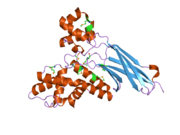ASCC3L1
Protein-coding gene in the species Homo sapiens
| SNRNP200 | |||||||||||||||||||||||||||||||||||||||||||||||||||
|---|---|---|---|---|---|---|---|---|---|---|---|---|---|---|---|---|---|---|---|---|---|---|---|---|---|---|---|---|---|---|---|---|---|---|---|---|---|---|---|---|---|---|---|---|---|---|---|---|---|---|---|
 | |||||||||||||||||||||||||||||||||||||||||||||||||||
| |||||||||||||||||||||||||||||||||||||||||||||||||||
| Identifiers | |||||||||||||||||||||||||||||||||||||||||||||||||||
| Aliases | SNRNP200, ASCC3L1, BRR2, HELIC2, RP33, U5-200KD, small nuclear ribonucleoprotein U5 subunit 200 | ||||||||||||||||||||||||||||||||||||||||||||||||||
| External IDs | OMIM: 601664; MGI: 2444401; HomoloGene: 5859; GeneCards: SNRNP200; OMA:SNRNP200 - orthologs | ||||||||||||||||||||||||||||||||||||||||||||||||||
| |||||||||||||||||||||||||||||||||||||||||||||||||||
| |||||||||||||||||||||||||||||||||||||||||||||||||||
| |||||||||||||||||||||||||||||||||||||||||||||||||||
| |||||||||||||||||||||||||||||||||||||||||||||||||||
| |||||||||||||||||||||||||||||||||||||||||||||||||||
| Wikidata | |||||||||||||||||||||||||||||||||||||||||||||||||||
| |||||||||||||||||||||||||||||||||||||||||||||||||||
U5 small nuclear ribonucleoprotein 200 kDa helicase is an enzyme that in humans is encoded by the SNRNP200 gene.[5][6][7][8][9]
References
- ^ a b c GRCh38: Ensembl release 89: ENSG00000144028 – Ensembl, May 2017
- ^ a b c GRCm38: Ensembl release 89: ENSMUSG00000003660 – Ensembl, May 2017
- ^ "Human PubMed Reference:". National Center for Biotechnology Information, U.S. National Library of Medicine.
- ^ "Mouse PubMed Reference:". National Center for Biotechnology Information, U.S. National Library of Medicine.
- ^ Nagase T, Ishikawa K, Suyama M, Kikuno R, Miyajima N, Tanaka A, Kotani H, Nomura N, Ohara O (Apr 1999). "Prediction of the coding sequences of unidentified human genes. XI. The complete sequences of 100 new cDNA clones from brain which code for large proteins in vitro". DNA Res. 5 (5): 277–86. doi:10.1093/dnares/5.5.277. PMID 9872452.
- ^ Lauber J, Fabrizio P, Teigelkamp S, Lane WS, Hartmann E, Luhrmann R (Oct 1996). "The HeLa 200 kDa U5 snRNP-specific protein and its homologue in Saccharomyces cerevisiae are members of the DEXH-box protein family of putative RNA helicases". EMBO J. 15 (15): 4001–15. doi:10.1002/j.1460-2075.1996.tb00774.x. PMC 452120. PMID 8670905.
- ^ Achsel T, Ahrens K, Brahms H, Teigelkamp S, Luhrmann R (Nov 1998). "The Human U5-220kD Protein (hPrp8) Forms a Stable RNA-Free Complex with Several U5-Specific Proteins, Including an RNA Unwindase, a Homologue of Ribosomal Elongation Factor EF-2, and a Novel WD-40 Protein". Mol Cell Biol. 18 (11): 6756–66. doi:10.1128/mcb.18.11.6756. PMC 109259. PMID 9774689.
- ^ Laggerbauer B, Achsel T, Luhrmann R (May 1998). "The human U5-200kD DEXH-box protein unwinds U4/U6 RNA duplices in vitro". Proc Natl Acad Sci U S A. 95 (8): 4188–92. Bibcode:1998PNAS...95.4188L. doi:10.1073/pnas.95.8.4188. PMC 22463. PMID 9539711.
- ^ "Entrez Gene: ASCC3L1 activating signal cointegrator 1 complex subunit 3-like 1".
External links
- Human SNRNP200 genome location and SNRNP200 gene details page in the UCSC Genome Browser.
Further reading
- Nakajima D, Okazaki N, Yamakawa H, et al. (2003). "Construction of expression-ready cDNA clones for KIAA genes: manual curation of 330 KIAA cDNA clones". DNA Res. 9 (3): 99–106. doi:10.1093/dnares/9.3.99. PMID 12168954.
- Laggerbauer B, Lauber J, Lührmann R (1996). "Identification of an RNA-dependent ATPase activity in mammalian U5 snRNPs". Nucleic Acids Res. 24 (5): 868–75. doi:10.1093/nar/24.5.868. PMC 145735. PMID 8600454.
- Meister G, Hannus S, Plöttner O, et al. (2001). "SMNrp is an essential pre-mRNA splicing factor required for the formation of the mature spliceosome". EMBO J. 20 (9): 2304–14. doi:10.1093/emboj/20.9.2304. PMC 125440. PMID 11331595.
- Andersen JS, Lyon CE, Fox AH, et al. (2002). "Directed proteomic analysis of the human nucleolus". Curr. Biol. 12 (1): 1–11. Bibcode:2002CBio...12....1A. doi:10.1016/S0960-9822(01)00650-9. PMID 11790298. S2CID 14132033.
- Jurica MS, Licklider LJ, Gygi SR, et al. (2002). "Purification and characterization of native spliceosomes suitable for three-dimensional structural analysis". RNA. 8 (4): 426–39. doi:10.1017/S1355838202021088. PMC 1370266. PMID 11991638.
- Peng R, Dye BT, Pérez I, et al. (2002). "PSF and p54nrb bind a conserved stem in U5 snRNA". RNA. 8 (10): 1334–47. doi:10.1017/S1355838202022070. PMC 1370341. PMID 12403470.
- Nakayama M, Kikuno R, Ohara O (2003). "Protein–Protein Interactions Between Large Proteins: Two-Hybrid Screening Using a Functionally Classified Library Composed of Long cDNAs". Genome Res. 12 (11): 1773–84. doi:10.1101/gr.406902. PMC 187542. PMID 12421765.
- Strausberg RL, Feingold EA, Grouse LH, et al. (2003). "Generation and initial analysis of more than 15,000 full-length human and mouse cDNA sequences". Proc. Natl. Acad. Sci. U.S.A. 99 (26): 16899–903. Bibcode:2002PNAS...9916899M. doi:10.1073/pnas.242603899. PMC 139241. PMID 12477932.
- Ota T, Suzuki Y, Nishikawa T, et al. (2004). "Complete sequencing and characterization of 21,243 full-length human cDNAs". Nat. Genet. 36 (1): 40–5. doi:10.1038/ng1285. PMID 14702039.
- Will CL, Schneider C, Hossbach M, et al. (2004). "The human 18S U11/U12 snRNP contains a set of novel proteins not found in the U2-dependent spliceosome". RNA. 10 (6): 929–41. doi:10.1261/rna.7320604. PMC 1370585. PMID 15146077.
- Vertegaal AC, Ogg SC, Jaffray E, et al. (2004). "A proteomic study of SUMO-2 target proteins". J. Biol. Chem. 279 (32): 33791–8. doi:10.1074/jbc.M404201200. PMID 15175327.
- Beausoleil SA, Jedrychowski M, Schwartz D, et al. (2004). "Large-scale characterization of HeLa cell nuclear phosphoproteins". Proc. Natl. Acad. Sci. U.S.A. 101 (33): 12130–5. Bibcode:2004PNAS..10112130B. doi:10.1073/pnas.0404720101. PMC 514446. PMID 15302935.
- Jin J, Smith FD, Stark C, et al. (2004). "Proteomic, functional, and domain-based analysis of in vivo 14-3-3 binding proteins involved in cytoskeletal regulation and cellular organization". Curr. Biol. 14 (16): 1436–50. Bibcode:2004CBio...14.1436J. doi:10.1016/j.cub.2004.07.051. PMID 15324660. S2CID 2371325.
- Gerhard DS, Wagner L, Feingold EA, et al. (2004). "The Status, Quality, and Expansion of the NIH Full-Length cDNA Project: The Mammalian Gene Collection (MGC)". Genome Res. 14 (10B): 2121–7. doi:10.1101/gr.2596504. PMC 528928. PMID 15489334.
- Andersen JS, Lam YW, Leung AK, et al. (2005). "Nucleolar proteome dynamics". Nature. 433 (7021): 77–83. Bibcode:2005Natur.433...77A. doi:10.1038/nature03207. PMID 15635413. S2CID 4344740.
- v
- t
- e
PDB gallery
-
 2q0z: Crystal structure of Q9P172/Sec63 from Homo sapiens. Northeast Structural Genomics Target HR1979.
2q0z: Crystal structure of Q9P172/Sec63 from Homo sapiens. Northeast Structural Genomics Target HR1979.
 | This enzyme-related article is a stub. You can help Wikipedia by expanding it. |
- v
- t
- e


















